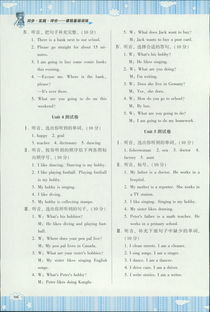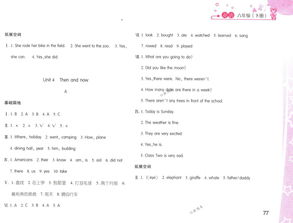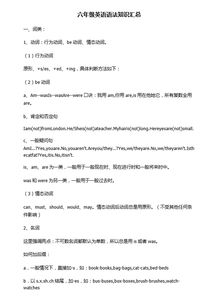人教版六级英语汇总(人教版六年级英语复习资料)
1.人教版六年级英语基础知识复习资料
PEP小学英语毕业总复习 一:学生易错词汇1. a, an的选择: 元音音素开头的单词用an,辅音音素开头的单词用a.2. am , is , are的选择: 单数用is , 复数用are, I 用 am , you 用 are.3. have , has 的选择: 表示某人有某物。
单数用has , 复数用have, I \you 用 have .4. there is, there are 的选择:表示某地有某物或某人。单数用there is , 复数用there are.5. some, any 的选择:肯定句用some, 疑问句和否定句用any.6. 疑问词的选择:what (什么) who (谁) where (哪里) whose (谁的) why(为什么)when(什么时候)which(哪一个)how old (多大) how many (多少)how much(多少钱) 二:形容词比较级详解 当我们需要对事物作出比较时,需要用到比较级。
比较级的句子结构通常是:什么 + 动词be (am , is , are ) + 形容词比较级 + than(比)+ 什么 ,如:I'm taller and heavier than you. (我比你更高和更重。) An elephant is bigger than a tiger. (一只大象比一只老虎更大。)
形容词的比较级是在形容词的基础上变化而来的,它的变化规则是:① 一般的直接在词尾加er ,如 tall - taller , strong - stronger ,② 以e结尾的,直接加r ,如 fine – finer ,③ 以辅音字母加y结尾的,先改y为i再加er,如funny - funnier ④ 双写最后的字母再加er,如big – bigger, thin – thinner ,hot – hotter ☆注意☆ 比较的两者应该是互相对应的可比较的东西。典型错误:My hair is longer than you.(我的头发比你更长。)
比较的两者是我的头发、你(整个人),那么比较的对象就没有可比性。应该改为:My hair is longer than yours. 或My hair is longer than your hair.比较级专项练习: 一、从下面中选出合适的单词完成句子 heavy tall long big(1) How is the Yellow River?(2) How is Mr Green? He's 175cm.(3) How are your feet? I wear size 18.(4)How is the fish? It's 2kg.二、根据句意写出所缺的单词(1) I'm 12 years old. You're 14. I'm than you.(2) A rabbit's tail is than a monkey's tail.(3) An elephant is than a pig.(4) A lake is than a sea.(5) A basketball is than a football.(贵的) 三、根据中文完成句子.(1) 我比我的弟弟大三岁. I'm than my brother.(2) 这棵树要比那棵树高. This tree than that one.(3) 你比他矮四厘米. You are than he.(4) 谁比你重? than you?四、根据答句写出问句(1) I'm 160 cm.(2) I'm 12 years old.(4) Amy's hair is 30 cm long.三:动词过去式详解 动词的过去式的构成规则有:A、规则动词 ① 一般直接在动词的后面加ed:如 worked , learned , cleaned , visited ② 以e结尾的动词直接加d:如 lived , danced , used ③ 以辅音字母加y结尾的动词要改y为i再加ed(此类动词较少)如 study – studied carry – carried worry – worried (注意play、stay不是辅音字母加y,所以不属于此类) ④ 双写最后一个字母(此类动词较少)如 stopped B、不规则动词(此类词并无规则,须熟记)小学阶段要记住以下动词的原形和过去式:sing – sang , eat – ate ,see – saw , have – had , do – did , go – went , take – took , buy – bought , get – got , read – read ,fly – flew , am/is – was ,are – were , say – said , leave – left , swim – swam , tell – told , draw – drew , come – came , lose – lost , find – found , drink – drank , hurt – hurt , feel – felt 四:动词现在分词详解 动词的ing形式的构成规则:① 一般的直接在后面加上ing , 如doing , going , working , singing , eating ② 以e 结尾的动词,要先去e再加ing ,如having , writing ③ 双写最后一个字母的(此类动词极少)有:running , swimming , sitting , getting 五:人称和数 人称代词 物主代词 主格 宾格 第一 人称 单数 I(我) me my(我的) 复数 we(我们) us our(我们的) 第二 人称 单数 you(你) you your(你的) 复数 you(你们) you your(你们的) 第三 人称 单数 he(他) him his(他的) she(她) her her(她的) it(它) it its(它的) 复数 they(他们/她们/它们) them their(他们的/她们的/它们的) 六:句型专项归类1、肯定句:是指用肯定的语气来陈述的句子,如:I'm a student. She is a doctor. He works in a hospital. There are four fans in our classroom. He will eat lunch at 12:00. I watched TV yesterday evening.2、否定句:含有否定词或表示否定意义词的句子,如:I'm not a student. She is not (isn't) a doctor. He does not (doesn't) work in a hospital. There are not (aren't) four fans in our classroom. He will not (won't) eat lunch at 12:00. I did not (didn't) watch TV yesterday evening.☆注意☆ 小结:否定句主要是在肯定句的基础上加上了否定词 “not”。
有动词be的句子则“not”加在be后面,可缩写成“isn't,aren't”,但am not 一般都分开写。没有动词be的句子则要先在主要动词的前面加上一个助动词(do,does,did),然后在它后面加上“not”,你也可以把它们缩写在一起如“don't , doesn't , didn't )。
这三个助动词要根据人称和时态来选择,其中“does”只用于一般现在时主语是第三人称单数的情况,而“did”只用于一般过去时,不论主语是什么人称和数,。

2.人教版六年级英语重点知识
六年级第一学期重点词汇和语言知识点(2012.1)一、六年级第一学期要求掌握的词汇中的重点词汇(80个)1 almost adv.几乎 41 kind adj.善良的,友好的 2 amazing adj.令人惊异的 42 laugh at v.嘲笑 3 another adj. 另一,再一 43 least adj. 最少的,最小的 4 area n.地区 44 less adj. 更少的,更小的 5 around prep.在周围 45 lemon n.柠檬 6 away adv. 远离,离开 46 late adj.迟的 7 beautiful adj.美丽的 47 lunchtime n.午餐时间 8 beef n.牛肉 48 medal n.奖牌 9 body n.身体 49 metre n.米 10 boil v.沸腾,煮… 50 minute n.分钟 11 brave adj. 勇敢的 51 Monkey King n.孙悟空 12 bright adj.明亮的,聪明的 52 most adj.最多 13 building n.楼,建筑物 53 near adj.近的 14 centimeter n.厘米 54 near to 离…近 15 character n.人物 55 New Zealand n.新西兰 16 city n.城市 56 planet n.行星 17 could conj.能,能够 57 pork n.猪肉 18 country n.国家,农村,乡下 58 province n.省 19 delicious adj.美味的 59 question n.问题 20 during prep.在期间 60 river n.河流 21 earth n.地球 61 runner n.赛跑者,操作者 22 exercise v.锻炼 62 salt n.盐 23 fact n.事实 63 second place n.第二名 24 famous adj.著名的 64 shark n.鲨鱼 25 far adj.远的 65 since conj.自从,既然,因为 26 first place n.第一名 66 smart adj.聪明的,伶俐的 27 funny adj.滑稽的 67 Snow White n.白雪公主 28 give out v.颁发 68 sour adj.酸的 29 hard-working adj.努力工作的 69 state n.州 30 heavy adj.重的 70 still adv.仍然 31 high adj.高的 71 strong adj.强壮的 32 honest adj.诚实的 72 talk about 谈论,讨论 33 huge adj.巨大的 73 talk to 和…说话 34 hurdle n.跨栏 74 team n.队,组 35 important adj.重要的 75 test n.测试 36 in fact 事实上 76 third place n.第三名 37 island n.小岛 77 wake up 叫醒, 醒来 38 Journey tothe West n.西游记 78 weak adj.虚弱的 39 jumper n.跳跃的人 79 weight n.哑铃 40 kilogram n.千克 80 winner n.获胜者 二、六年级第一学期要求掌握的重点语言知识点(Book 11,约20个核心句子):Last year, you were tall. This year, you are taller.I was short. This year, I'm taller and heavier. I'm taller than Kim now.Peter is faster than Tom.The longest river in China is the Yangtze River.What is the highest mountain in the world?Mount Qomolangma is the highest mountain in the world.The sun is huge. It's much bigger than the Earth. The Earth is one of the hottest planets.You're a better jumper this year than last year. Alice is the best jumper in the school.They won more medals than Dragon Team.They won the most medals and they are in first place.She had the best score. He had the most gold medals.He was the fastest runner in the 2004 Olympics. His record was 7.81 seconds.I like Monkey King the best.He is the most interesting character.She is more beautiful than Cinderella.I like vegetables so I brought vegetable soup.I need some water or juice.I put in lots of chocolate and sugar. It's delicious but it's not healthy to eat too much sweet food.。

3.六年级英语知识点
小升初六年级英语语法知识复习全面汇总2013-09-16 一、词类: 动词、名词和形容词不太容易区分,如不能一眼看出,可用如下方法: 先用“一(量词)”(如:一个、一张等)和这个词连起来说,如说得通,一般认为是名词;说不通再用“很”去判断,就是把“很”和为个词连起来说,说得通一般就是形容词;都说不通就是动词。
(目前我们学过的,以后可能不同)(另外一些很明显的,如人称代词、数词、情态动词等一下就可以知道) 1、动词 这里所说的动词是指各种动词总称,其中包括行为动词(就是我们平时总说的那种动词)、be动词、情态动词。 (1)行为动词 就是我们平时上课时说的动词,表示某一动作或行为。
如:sweep、live等。 行为动词我们已学过它们的四种形式: 原形、+s/es、+ed、+ing,具体判断方法如下: ↗有,就加ing 读句子→读该单词→认识该单词→理解意思→看有无be动词 (若是be going to 就用原形) ↘没有,再看情态动词 ↗有,就用原形 ↗有,就加ed ↘没有,再看有无表示过去的时间状语 ↗是第三人称单数就加s或es ↘没有,再看主语 ↘不是第三人称单数就用原形 (2)be动词 a、Am--was Is --was Are--were 口诀:我用am, 你用are, is用在他她它,所有复数全用are。
b、肯定和否定句 I am (not) from London. He is(not) a teacher. She is(not) in the dining room. My hair is(not) long. Her eyes are(not) small. c、一般疑问句 Am I a Chinese? Yes, you are. No, you aren't. Are they American? Yes, they are. No, they aren't. Is the cat fat? Yes, it is. No, it isn't. 我们现在学过的be动词大致分两类:is、am、are为一类,一般用于一般现在时、现在进行时和一般将来时中,was和were为另一类,一般用于一般过去时。 判断步骤: ↗第一、三人称单数,就用was ↗有,再看人称 ↘第二人称单数和所有复数,就用were 看有无表示过去的时间状语 ↗第一人称单数,就用am ↘没有,再看人称→第三人称单数,就有is ↘第二人称单数和所有复数,就用are (3)情态动词 情态动词也是一类特殊的动词,平时我们不把它说成是动词。
情态动词可以和行为动词同时出现在同一个句子中。 我们现在学过的情态动词有:can、must、should、would、may。
接触最多的是can。 情态动词后动词总是用原形。
(不受其他任何条件影响) 2、名词 表示某一事物,有具体的和抽象的之分。判断的关键词往往是be动词,be动词如果是am、is或was,名词就用原形;be动词如果是are或were,名词就加s或es。
这里强调两点:不可数名词都默认为单数,所以总是用is或者was;最好不要根据some、any、a lot of等词去作判断,以免受误导。 如何加后缀: a.一般情况下,直接加-s,如:book-books, bag-bags, cat-cats, bed-beds b.以s. x. sh. ch结尾,加-es,如:bus-buses, box-boxes, brush-brushes, watch-watches c.以“辅音字母+y”结尾,变y为i, 再加-es,如:family-families, strawberry-strawberries d.以“f或fe”结尾,变f或fe为v, 再加-es,如:knife-knives e.不规则名词复数: man-men, woman-women, policeman-policemen, policewoman-policewomen, mouse-mice child-children foot-feet ,.tooth-teeth fish-fish, people-people, Chinese-Chinese, Japanese-Japanese 判断步骤: ↗如是am、is或was→原形 读句子→读该单词→认识该单词→理解意思→看be动词 ↘如是are或were→加s或es 3、形容词(包括副词) 形容词表示某一事物或的特征,副词表示某一动作的特征。
形容词和副词只有两种形式:原形和+er。 未作比较的情况下就用原形,比较时就+er。
两个重要特征:as……as中间一定用原形,有th。
4.人教版六年级英语基础知识复习资料
PEP小学英语毕业总复习一:学生易错词汇1. a, an的选择: 元音音素开头的单词用an,辅音音素开头的单词用a.2. am , is , are的选择: 单数用is , 复数用are, I 用 am , you 用 are.3. have , has 的选择: 表示某人有某物。
单数用has , 复数用have, I \you 用 have .4. there is, there are 的选择:表示某地有某物或某人。单数用there is , 复数用there are.5. some, any 的选择:肯定句用some, 疑问句和否定句用any.6. 疑问词的选择:what (什么) who (谁) where (哪里) whose (谁的) why(为什么)when(什么时候)which(哪一个)how old (多大) how many (多少)how much(多少钱) 二:形容词比较级详解当我们需要对事物作出比较时,需要用到比较级。
比较级的句子结构通常是:什么 + 动词be (am , is , are ) + 形容词比较级 + than(比)+ 什么 ,如:I'm taller and heavier than you. (我比你更高和更重。)An elephant is bigger than a tiger. (一只大象比一只老虎更大。)
形容词的比较级是在形容词的基础上变化而来的,它的变化规则是:① 一般的直接在词尾加er ,如 tall - taller , strong - stronger ,② 以e结尾的,直接加r ,如 fine – finer ,③ 以辅音字母加y结尾的,先改y为i再加er,如funny - funnier④ 双写最后的字母再加er,如big – bigger, thin – thinner ,hot – hotter☆注意☆ 比较的两者应该是互相对应的可比较的东西。典型错误:My hair is longer than you.(我的头发比你更长。)
比较的两者是我的头发、你(整个人),那么比较的对象就没有可比性。应该改为:My hair is longer than yours. 或My hair is longer than your hair.比较级专项练习: 一、从下面中选出合适的单词完成句子heavy tall long big(1) How is the Yellow River?(2) How is Mr Green? He's 175cm.(3) How are your feet? I wear size 18.(4)How is the fish? It's 2kg.二、根据句意写出所缺的单词(1) I'm 12 years old. You're 14. I'm than you.(2) A rabbit's tail is than a monkey's tail.(3) An elephant is than a pig.(4) A lake is than a sea.(5) A basketball is than a football.(贵的)三、根据中文完成句子.(1) 我比我的弟弟大三岁. I'm than my brother.(2) 这棵树要比那棵树高. This tree than that one.(3) 你比他矮四厘米. You are than he.(4) 谁比你重? than you?四、根据答句写出问句(1) I'm 160 cm.(2) I'm 12 years old.(4) Amy's hair is 30 cm long.三:动词过去式详解 动词的过去式的构成规则有:A、规则动词① 一般直接在动词的后面加ed:如 worked , learned , cleaned , visited② 以e结尾的动词直接加d:如 lived , danced , used③ 以辅音字母加y结尾的动词要改y为i再加ed(此类动词较少)如 study – studied carry – carried worry – worried (注意play、stay不是辅音字母加y,所以不属于此类)④ 双写最后一个字母(此类动词较少)如 stopped B、不规则动词(此类词并无规则,须熟记)小学阶段要记住以下动词的原形和过去式:sing – sang , eat – ate ,see – saw , have – had , do – did , go – went , take – took , buy – bought , get – got , read – read ,fly – flew , am/is – was ,are – were , say – said , leave – left , swim – swam , tell – told , draw – drew , come – came , lose – lost , find – found , drink – drank , hurt – hurt , feel – felt四:动词现在分词详解 动词的ing形式的构成规则:① 一般的直接在后面加上ing , 如doing , going , working , singing , eating② 以e 结尾的动词,要先去e再加ing ,如having , writing③ 双写最后一个字母的(此类动词极少)有:running , swimming , sitting , getting五:人称和数 人称代词 物主代词 主格 宾格 第一人称 单数 I(我) me my(我的) 复数 we(我们) us our(我们的)第二人称 单数 you(你) you your(你的) 复数 you(你们) you your(你们的)第三人称 单数 he(他) him his(他的) she(她) her her(她的) it(它) it its(它的) 复数 they(他们/她们/它们) them their(他们的/她们的/它们的)六:句型专项归类1、肯定句:是指用肯定的语气来陈述的句子,如:I'm a student. She is a doctor. He works in a hospital. There are four fans in our classroom. He will eat lunch at 12:00. I watched TV yesterday evening.2、否定句:含有否定词或表示否定意义词的句子,如:I'm not a student. She is not (isn't) a doctor. He does not (doesn't) work in a hospital. There are not (aren't) four fans in our classroom. He will not (won't) eat lunch at 12:00. I did not (didn't) watch TV yesterday evening.☆注意☆ 小结:否定句主要是在肯定句的基础上加上了否定词 “not”。
有动词be的句子则“not”加在be后面,可缩写成“isn't,aren't”,但am not 一般都分开写。没有动词be的句子则要先在主要动词的前面加上一个助动词(do,does,did),然后在它后面加上“not”,你也可以把它们缩写在一起如“don't , doesn't , didn't )。
这三个助动词要根据人称和时态来选择,其中“does”只用于一般现在时主语是第三人称单数的情况,而“did”。
5.6年级英语语法的主要知识
小学六年级英语语法知识汇总 一、词类:1、动词:行为动词、be动词、情态动词。
(1)行为动词 原形、+s/es、+ed、+ing,具体判断方法如下:(2)be动词 a、Am--was Is --was Are--were 口诀:我用am, 你用are, is用在他她它,所有复数全用are。b、肯定和否定句 I am (not) from London. He /She is(not) a teacher. My hair is(not) long. Her eyes are(not) small. c、一般疑问句 Am I …? Yes, you are. No, you aren't. Are you/they…? Yes,we/ they are. No,we/ they aren't. Is the cat fat? Yes, it is. No, it isn't. is、am、are为一类,一般用于一般现在时、现在进行时和一般将来时中。
was和were为另一类,一般用于一般过去时。(3)情态动词 can、must、should、would、may。
情态动词后动词总是用原形。(不受其他任何条件影响)2、名词 这里强调两点:不可数名词都默认为单数,所以总是用is或者was。
如何加后缀:a.一般情况下,直接加-s,如:book-books, bag-bags, cat-cats, bed-beds b.以s. x. sh. ch结尾,加-es,如:bus-buses, box-boxes, brush-brushes, watch-watches c.以“辅音字母+y”结尾,变y为i, 再加-es,如:family-families, strawberry-strawberries d.以“f或fe”结尾,变f或fe为v, 再加-es,如:knife-knives e.不规则名词复数: man-men, woman-women, policeman-policemen, policewoman-policewomen, mouse-mice child-children foot-feet ,.tooth-teeth fish-fish, people-people, Chinese-Chinese, Japanese-Japanese 3、形容词(包括副词) 形容词表示某一事物或的特征,副词表示某一动作的特征。形容词和副词只有两种形式:原形和+er。
未作比较的情况下就用原形,比较时就+er。两个重要特征:as……as中间一定用原形,有than的时候一定+er。
4、人称代词和物主代词 人称代词物主代词 单数 复数 单数 复数 主格 宾格 主格 宾格 形容词性(短) 名词性(长) 形容词性(短) 名词性(长) 第一人称I me we us my mine our ours 第二人称you you you you your yours your yours 第三人称he him they them his his their theirs She her her hers It it its its 人称代词:有主格和宾格之分。一般动词前用主格,动词后用宾格。
物主代词:有两类:形容词性物主代词(短的)和名词性物主代词(长的) 一般看后面有没有名词,如有,就用形容词性物主代词(短的);如无,就用名词性物主代词(长的)。5、数量词 我们学过两类:基数词和序数词。
基数用于表示数量多少,而基数词用于表示次序,常在日期中出现。序数词的前面一般都加the。
6、冠词 有a、an、the。a和an的区别:an用于元音音素(一般就是元音字母aeiou)前,a用于辅音音素前。
二、否定句:be动词(am、is、are、was、were)+not、情态动词(can、must、should)+ not、助动词(do、does、did) + not 如何将一个肯定的陈述句改为否定句:1、看句中有无be动词,如有,直接在be动词后+ not。2、看句中有无情态动词,如有,直接在情态动词后+ not。
3、如上述二者都没有,就应用助动词+ not。分四个步骤:(1)肯定陈述句中本来是没有助动词的,要加上去,位置在主语(某人或某物)后,动词前。
(2)确定助动词用do、does还是did,根据句中动词,动词是原形的助动词就用do,动词是第三人称单数的助动词就用does,动词用过去式的助动词就有did。(3)在助动词后加not。
(4)原句中动词假如发生变化就要恢复成原形。强调一点,有some的要考虑是否要用any。
三、一般疑问句。如何将一个肯定的陈述句改为否定句:1、看句中有无be动词,如有,把be动词提到句首即可。
2、看句中有无情态动词,如有,把情态动词提到句首即可。3、如上述二者都没有,就应把助动提到句首。
分四个步骤:(1)肯定陈述句中本来是没有助动词的,要加上去,位置在主语(某人或某物)后,动词前。(2)确定助动词用do、does还是did,根据句中动词,动词是原形的助动词就用do,动词是第三人称单数的助动词就用does,动词用过去式的助动词就有did。
(3)把助动词后提到句首。(4)原句中动词假如发生变化就要恢复成原形。
强调一点,有some的要考虑是否要用any。四、特殊疑问句。
表示疑问,有疑问词(在开头),回答有很多种可能。常用疑问词: 疑问词意思用法 When什么时间问时间 What time 什么时间问具体时间,如几点钟 Who谁问人 Whose 谁的问主人 Where在哪里问地点 Which哪一个问选择 Why 为什么问原因 What 什么问东西、事物 What colour什么颜色问颜色 What about。
怎么样问意见 What day星期几问星期几 What date什么日期问日期 What for 为何目的问目的 How 。
怎样问情况 How old多大年纪问年纪 How many多少数量(可数名词)问数量 How much多少钱;多少数量(不可数名词)问多少钱或数量(不可数) How about。
怎么样问意见 How often多久问频率 How long多长时间问时间长度 how soon 指再过多久,主要用来对表示将来的一段时间 How far 多远问多远;多长距离 五、祈使句 表示请求或命令别人做某事或不要做某事。
肯定祈使句一定是以动词原形开头(有时有please)。
6.六年级英语复习资料
小学英语语法汇总一、时 态 小 结时态 定义 特征 动词的变化规则一般现在时 表示经常性或习惯性的动作. every day/morning/…usually 第三人称单数的变化情况:1. 一般情况在词尾直接加-s2. 以ch,sh,s,x或o结尾的词加-es(wishes)3. 以辅音字母加y结尾的词,将y改成i再加-es(flies)现在进行时 表示现在或现在一阶段正在进行的动作. now/ look/ listen 现在分词的变化情况:1. 一般情况在词尾直接加-ing2. 以e结尾的词,去掉e再加-ing(skating)3. 以重读闭音节结尾的词,双写最后一个字母加-ing (swimming)一般过去时 表示过去某时发生的动作或情况. yesterday morning/afternoon/eveninglast year/montha minute ago/an hour agothis morning/afternoon/evening 动词过去式的变化情况:1. 一般情况在词尾直接加-ed2. 以e结尾的词加-d(lived)3. 以辅音字母加y结尾的词,将y改成i再加-ed(flied)4. 以重读闭音节结尾的词,双写最后一个字母加-ed(stopped)一般将来时 表示将要发生的事情 tomorrowthe day after tomorrow/the next day/Monday…at the weekend/tonighttomorrow night/morning/afternoon 主要构成be going to/will + 动词原形 be +形容词凡是在must, mustn't, can, can't, let's, don't, may,will后的一定要用动词的原形二、名词的复数。
名词按其数,可分两种:可数名词和不可数名词. 可数名词的复数变化规则:1.一般情况下,直接在词尾加-s, 如:girl-girls, book-books, pen-pens2.以s,x,sh,ch结尾的词,在词后加-es, 如:class-classes, box-boxes, match-matches,3.以辅音字母+y结尾的,变y 为i 再加-es, 如:city-cities, family-families, country- countries4.以f或fe结尾的,变f或fe为v再加-es, 如:knife-knives, wife-wives, life-lives,5.以o 结尾的加-es或-s, 如: radio-radios, tomato-tomatoes, potato-potatoes, zoo-zoos, photo-photos,6.man-men, woman-women, foot-feet, child-children,三、形容词的比较级、最高级。 形容词有比较级与最高级之分, 单音节词的变化规则:1.一般情况下,直接在词尾加-er或-est, 如:small-smaller-smallest, short-shorter-shortest2.以e结尾的,直接加-r或-st, 如:large-larger-largest, nice-nicer-nicest.3.以辅音字母+y结尾的, 变y 为i 再加-er或-est, 如:busy-busier-busiest, heavy-heavier-heaviest. 4.以重读闭音节,一个辅音字母结尾的,双写该字母,再加-er或-est, 如:big-bigger-biggest, thin-thinner-thinnest.5.多音节的词,前加more, most, 如: beautiful-more beautiful-most beautiful. 6.good-better-best四、be 动词,助动词。
现阶段be动词形式有: am, is, are, were, was, isn't, aren't, weren't, wasn't助动词形式有: do, does, did, don't, doesn't, didn't※ 1. 在英语句子中进行变化的时候, 有be动词的就在be动词上变化,变 “过去”, “否定”; 否定 过去 否定am-------am not(第一人称 “I” ) am, is ---wasn't is ------- isn't (第三人称) are -----weren't are------aren't (you和其它人称)2. 没有be动词的就要加助动词; 否定 过去 过去否定do -----don't ------did---------didn'tdoes(第三人称单数)-----doesn't ------did---------didn't五.人称代词主语 物主代词 宾格 形容词性 名词性 I my mine meshe her hers herhe his his himit its its ityou your yours youwe our ours usthey their theirs them可数名词与不可数名词“分家”一、可数名词与不可数名词的区别 普通名词所表示的人或事物是可以按个数计算的,这类名词叫可数名词。可数名词分为个体名词(表示某类人或事物中的个体,如worker, farmer, desk, factory等)和集体名词(表示作为一个整体来看的一群人或一些事物,如people, family 等)。
如果普通名词所表示的事物是不能按个数来计算的,这类名词就叫不可数名词。不可数名词分为物质名词(表示无法分为个体的物质,如meat, rice, water, milk, orange 等)和抽象名词(表示动作、状态、情况、品质等抽象概念,如work, homework, time, health, friendship等)。
二、可数名词 可数名词有单数和复数两种形式。指一个人或一件事物时,用单数形式;指两个或多个人或事物时用复数形式。
名词由单数形式变成复数形式的规则如下:1. 一般的名词词尾直接加-s 。如:book → books room → rooms house → houses day → days2. 以s, ss, ch, sh, x 结尾的名词,在词尾加-es 。
如:bus → buses glass → glasses watch → watches dish → dishes box → boxes3. 以"辅音字母+y"结尾的名词,要先将y改为i再加-es。如:city → cities body → bodies factory → factories等等。
4. 以f 或fe 结尾的名词,要将f或fe改为v再加-es。如:half → halve leaf → leaves knife → knives wife → wives5. 特例 ① child → children② man → men woman → womenpoliceman → policemen(规律:man → men) ③ tomato → tomatoes potato → potatoes [ 初中英语以o 结尾的名词变复数时只有这两个词加-es,其余的当然加-s喽!如:photo → photos ]④ foot → feet tooth → teeth⑤ sheep, Chinese, Japanese单、复数同形 [悄悄话:变复数时词形不变。
]⑥ people单数形式表示复数意义,要求谓语动词用复。

相关推荐
声明:本网站尊重并保护知识产权,根据《信息网络传播权保护条例》,如果我们转载的作品侵犯了您的权利,请在一个月内通知我们,我们会及时删除。
蜀ICP备2020033479号-4 Copyright © 2016 学习鸟. 页面生成时间:5.235秒









